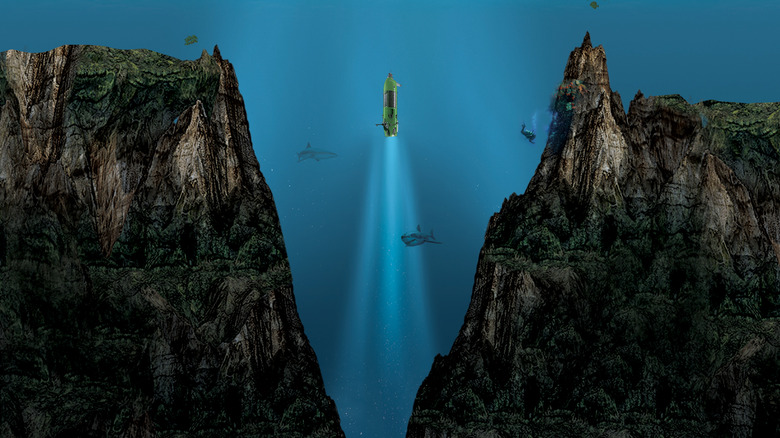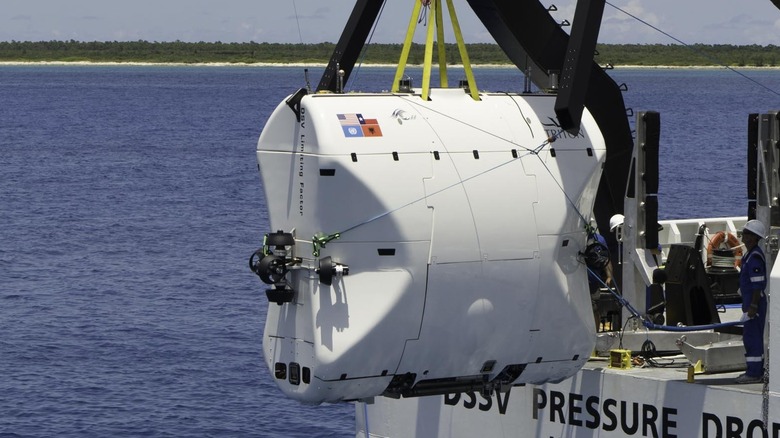The Deepest Depth Any Person Has Explored In The Ocean
In the summer of 2023, the world's attention turned to the North Atlantic as a frantic search was underway for the missing Titan submersible and its crew of adventurous billionaires. Eventually, it emerged that the sub had imploded, which itself highlighted some of the dangers that lie beneath the waves. The submersible was attempting to reach the Titanic's wreckage, which came to rest in two pieces around 12,500 feet down on the seabed of the Atlantic Ocean.
Major design flaws and lax safety measures came under scrutiny, and the whole incident put an emphasis on why you can't mess around when diving deep beneath the waves: pressure builds quickly as the weight of all of the water above an object is essentially acting on it. Above water at sea level, the pressure stands at "one atmosphere," or 14 pounds per square inch. When diving, another atmosphere is added every 33 feet you go down.
At the Titanic's wreck site, submersibles are exposed to pressures of around 6,000 psi, which means roughly three tons pressing on every square inch. Any hull failures are instant and catastrophic, and anyone unfortunate to be inside ceases to exist before their brain can even register an issue. In light of that, you may be surprised to learn that someone has successfully traveled to even greater depths.
James Cameron has been there
The Titanic doesn't sit at the deepest point in our oceans, far from it. The actual deepest point is thousands of miles away in the Pacific. Close to Guam is the Mariana Trench, and within the Mariana Trench lies a section called the Challenger Deep. This goes around 35,876 feet down and is the deepest point we know about. The pressure at the bottom is more than 16,000 psi, which is close to three times what a vessel would experience at the Titanic's wreck. A number of explorers have experienced both depths, with the most notable being director James Cameron.
Cameron first dived to the Titanic when he was filming the Oscar-winning 1997 movie based on the ship's sinking. He performed several dives to the wreckage but decided one in the early 2000s would be his last. However, this didn't spell the end of his ocean-going adventures. The filmmaker sought a new challenge, and that involved going as deep as it was possible to go. Cameron took a 28-foot submersible to the bottom of the ocean, breaking the record for the deepest solo dive in the process.
The mission was documented in the movie "James Cameron's Deep Sea Challenge," which can, at the time of writing, be viewed for free on a number of streaming services — if you want to glimpse the bottom of the ocean for yourself. The entire trip took around 70 minutes, and the Deepsea Challenger was specially designed to make the journey. The sub has since been retired but is occasionally loaned to museums for display purposes. Despite arguably being the most famous person to make the journey, Cameron is not the only person to get to the bottom of the Challenger Deep — and someone else has gone even deeper.
Someone has gone even deeper
The first manned journey to the bottom of the trench took place in 1960 when U.S. Navy Captain Don Walsh and a Swiss man named Jacques Piccard made it to the deepest point on Earth in a bathyscaphe called Trieste. This marked the only human dive to the bottom of the Challenger Deep for decades, but we seem to be making up for lost time with interest spiking over the last few years. These days, several nations have craft capable of hitting this depth, and trips to the ocean's deepest point are becoming increasingly common. James Cameron did hold the solo depth record for several years with a dive of 35,787 feet, but that has since been surpassed.
According to Guinness, the current record stands at 35,872 feet and is held by a private equity investor named Victor Vescovo. The record was achieved in a submersible called DSV Limiting Factor. The vessel was used as part of the successful "Five Deeps" expedition that saw Vescovo travel to the deepest points of all five of the world's oceans. Vescovo has made the dive 15 times, with his deepest effort beating James Cameron's dive by close to 100 feet. While these dives are the deepest humans have ever ventured, it turns out the ones making the trip aren't alone when they hit the bottom.
What lurks in the ocean's depths?
Despite the crushing pressures and perpetual darkness, life finds a way to exist even in the deepest parts of our oceans. James Cameron's trip alone resulted in the discovery of 68 new life forms, which he described as "most of them bacteria, but some small invertebrates." The species Cameron found were brought back to the surface for further study, in what would be a prime example of alien abduction if said bacterium and invertebrate species had the cranial capacity to process such a thing.
A further study from 2013 found the deepest point of the Mariana Trench was absolutely teaming with bacteria. In fact, it's estimated there are around 10 times more bacteria at the bottom of the trench than there are in the waters surrounding it. The actual tests that were analyzed were conducted by a remotely operated robot at the bottom of the trench itself back in 2010 — before Cameron made his descent.
In an ideal world, these vessels would be the only manmade objects ever to touch the ocean's deepest point. Sadly, this isn't the case and you may well have held something that has made a similar journey in your own hands. Litter, specifically plastic waste, has been found at the bottom of the Challenger Deep. It's just another strange location, like arctic snow and the average American digestive system, plastics have unintentionally made their way to.


